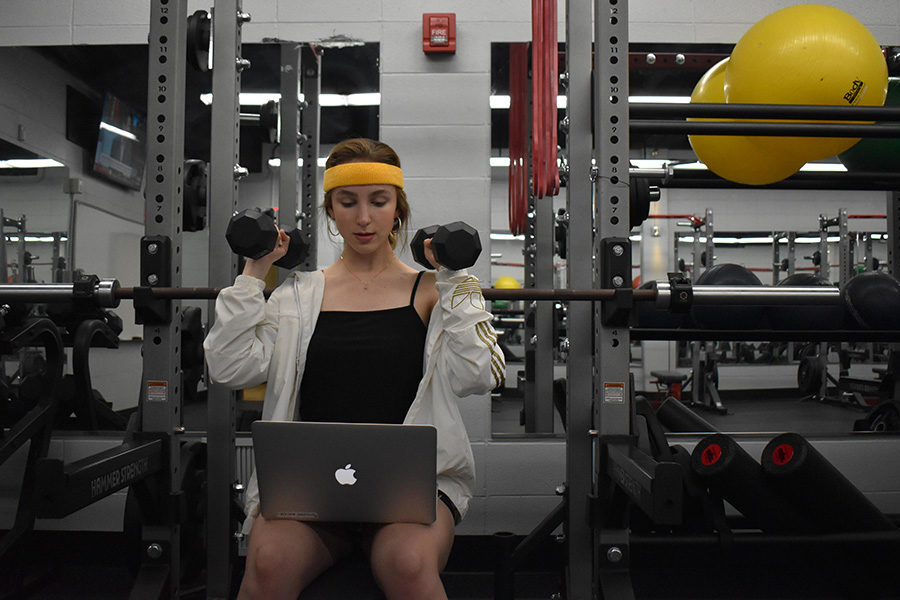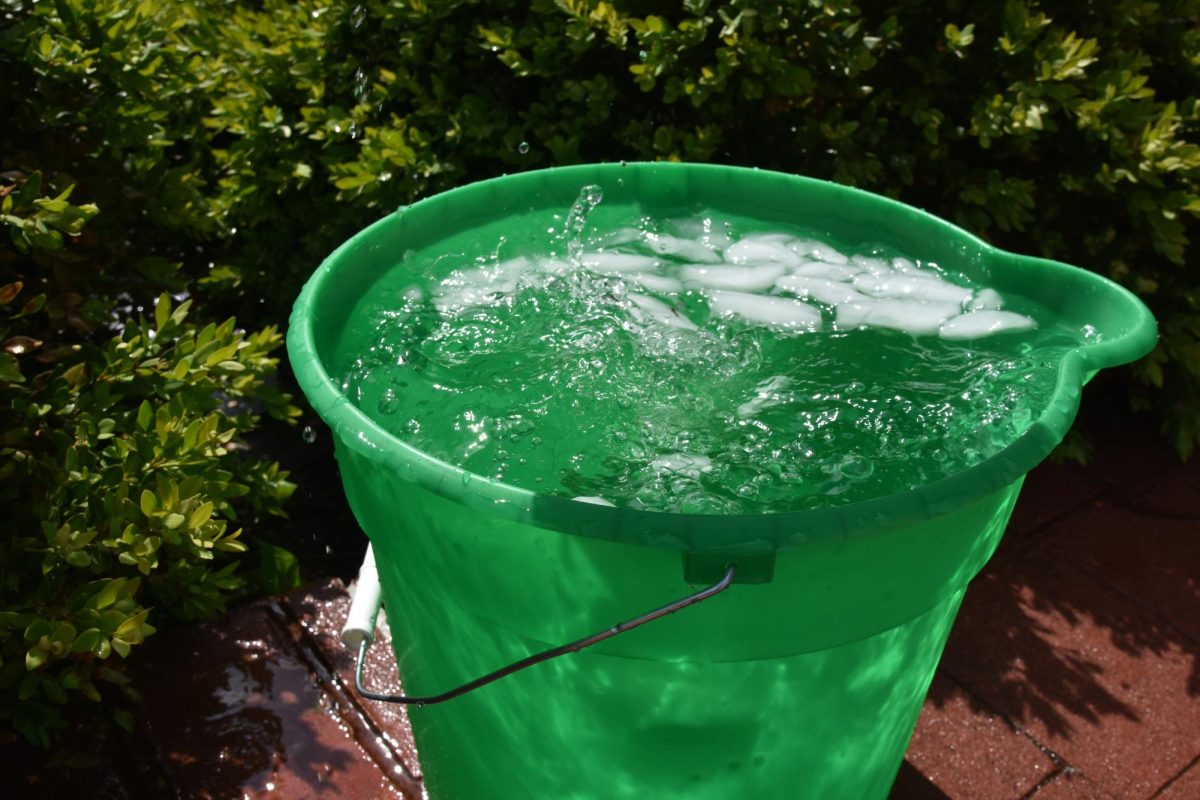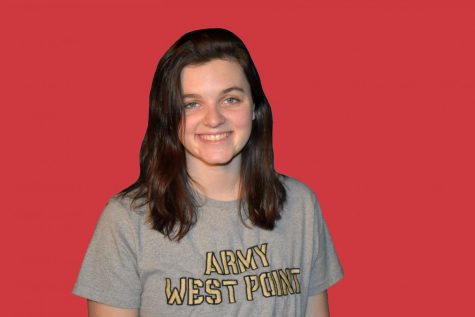Students scale rock walls, dance to cultural music, toss frisbees, lift heavyweights and earn scuba certifications within the large assortment of physical education courses that Parkway offers. Adding to the selection of physical education courses, online physical education is going to be offered beginning in the summer of 2020, thanks to new Missouri legislation requiring more courses to be available online through the Missouri Course Access Program (MOCAP).
Though online courses are nothing new to public education, staff members are unsure of what physical education will look like online.
“There’s something about playing games with other people, and I don’t know how [that] can be replicated online,” Senior Class Principal Corey Sink said. “I’m interested to know how they’re going to do it. I’m not saying it’s not possible, I just don’t know what it will look like because it’s new—but that’s the thing, education needs innovators, it needs people who are going to be thinkers and are going to see possibilities.”
According to Health and Physical Education Coordinator Eddie Mattison, the physical aspect of the online course will be tracked by a wearable device that students will upload onto a platform for teachers to see. Despite this, physical education teachers are worried of the impact that the lack of physical activity during the school day will have on the students taking the online course from home.
“I think we’re going to see a lot more stress. I couldn’t tell you a percentage, but I know from what I’ve seen and things that have happened that there is a lot more anxiety in this school, in every school, than there ever has been,” physical education teacher Tommie Rowe said. “Online, [students] are not getting that conversation between two students who might realize they have a struggle in common.”
MOCAP requires online courses to be offered so that, among other reasons, students can take classes to fulfill their graduation requirements even if they may not have room in their schedule. While online physical education fulfills the graduation requirement, Rowe feels that a brick and mortar physical education class is essential for all students to take.
“In my mind, there will be two types of students who take online physical education. There will be the kids who want to take all AP courses, which I understand, but we are unique in that we offer so many courses that can relieve the stress of AP classes. Then there will also be the kids who are athletes on the fast track to play college ball who think, ‘I don’t need this.’ They may make it, if they’re superstars, but they’re not sure, so they need to learn to exercise outside of their sport, which is why I push for athletes to take physical education classes,” Rowe said. “These kids are under pressure to perform, in their classes and their sport, and these classes can help ease that stress. In our classes, yes, we push you, but you’re learning life skills.”
Alongside Rowe, Sink supports the community aspect of a traditional physical education class and values the face-to-face relationship between a teacher and student.
“While you might be able to get through the curriculum online, it’s the relationship between a teacher and a student that makes the biggest difference, and I would never want to lose that, or think that that is nothing more than just an interface between social media and computer interaction,” Sink said. “It’s connections between people that help us learn. I don’t want to ever think that that’s not going to be part of what we do.”
Though the classic style of physical education appeals to Sink, he also recognizes the ways the education is evolving and wants to ensure that this school stays up to date.
“If I were a physical education teacher I would want to look at this as an opportunity. ‘What can I build? What can I design differently that kids will want to take advantage of, either here at school or online?’” Sink said. “We ask students to learn how to be adaptable because that’s what they’ll do in life, but we need to learn that same lesson as educators. We can’t just continue to say that we’re always going to do things the same way. We have to be adaptable if we’re going to ask our students to do the same.”




![Smiling in a sea of Longhorns, Fox 2 reporter Ty Hawkins joins junior Darren Young during the morning Oct. 3 pep rally. The last time West was featured in this segment was 2011. “[I hope people see this and think] if you come to [Parkway] West, you will have the time of your life because there are so many fun activities to do that make it feel like you belong here. I was surprised so many people attended, but it was a lot of fun,” Young said.](https://pwestpathfinder.com/wp-content/uploads/2025/10/Edited2-1200x798.jpg)
![West High seniors and families listen as a representative of The Scholarship Foundation of St. Louis, Teresa Steinkamp, leads a Free Application for Federal Student Aid (FAFSA) workshop. This session, held in the library, provided guidance on financial aid, scholarships and student loan options. “This event is very beneficial for any seniors who are applying to or considering applying to colleges after high school [because] the cost of college is on the rise for seniors and parents,” college and career counselor Chris Lorenz said.](https://pwestpathfinder.com/wp-content/uploads/2025/09/DSC_4478-1200x778.jpg)
![Senior Kamori Berry walks across the field during halftime at the Homecoming football game on Sept. 12. During the pep assembly earlier that day, she was pronounced Homecoming Queen. “I thought it was nice that the crowd [started] cheering right away. I know [my friends] were really excited for me, and my family was happy because typically non-white people don't win,” Berry said.](https://pwestpathfinder.com/wp-content/uploads/2025/09/DSC7046-Enhanced-NR-1200x798.jpg)



![Pitching the ball on Apr. 14, senior Henry Wild and his team play against Belleville East. Wild was named scholar athlete of the year by St. Louis Post-Dispatch after maintaining a high cumulative GPA and staying involved with athletics for all of high school. “It’s an amazing honor. I feel very blessed to have the opportunity to represent my school [and] what [it] stands for,” Wild said.](https://pwestpathfinder.com/wp-content/uploads/2025/05/unnamed-6-1200x714.jpg)
![The Glory of Missouri award recipients stand with their certificates after finding out which virtue they were chosen to represent. When discovering their virtues, some recipients were met with contented confirmation, while others, complete surprise. “I was not at all surprised to get Truth. I discussed that with some of the other people who were getting the awards as well, and that came up as something I might get. Being in journalism, [Fellowship of Christian Athletes and] Speech and Debate, there's a culture of really caring about truth as a principle that I've tried to contribute to as well. I was very glad; [Truth] was a great one to get,” senior Will Gonsior said.](https://pwestpathfinder.com/wp-content/uploads/2025/04/Group-Glory-of-Missouri.jpg)

![After a thrilling point, senior Katie Byergo and junior Elle Lanferseick high-five each other on Oct. 8. With teamwork and camaraderie, Byergo worked together in the game against Lafayette High School. “[Byergo’s] is really positive with a good spirit,” Lanferseick said. “I set her [the ball] and she hits it [or] gets the kill.”](https://pwestpathfinder.com/wp-content/uploads/2025/10/DSC_9349-1-e1761159125735-1200x791.jpg)
![Focused on providing exceptional service, sophomore Darsh Mahapatra carefully cleans the door of a customer’s car. Mahapatra has always believed his customers deserve nothing less than the best. “[If] they’re trusting us with their car and our service, then I am convinced that they deserve our 100 percent effort and beyond,” Mahapatra said.](https://pwestpathfinder.com/wp-content/uploads/2025/10/DSC_0018-1200x800.jpg)
![Sophomore Aleix Pi de Cabanyes Navarro (left) finishes up a soccer game while junior Ava Muench (right) warms up for cross country practice. The two came to Parkway West High School as exchange students for the 2025-2026 school year. “The goal for the [exchange] program is to provide opportunities for both Parkway students and our international exchange students to learn about other cultures, build connections and become confident, capable, curious and caring — Parkway’s Four C’s — in the process,” Exchange Program Lead Lauren Farrelly said.](https://pwestpathfinder.com/wp-content/uploads/2025/10/Feature-Photo-1200x800.png)
![Leaning on the podium, superintendent Melissa Schneider speaks to Parkway journalism students during a press conference. Schneider joined Parkway in July after working in the Thompson School District in Colorado. “My plan [to bond with students] is to get things on my calendar as much as possible. For example, being in [classes] is very special to me. I am trying to be opportunistic [meeting] kids [and] being in [the school] buildings. I have all the sports schedules and the fine arts schedules on my calendar, so that when I'm available, I can get to them,” Schneider said.](https://pwestpathfinder.com/wp-content/uploads/2025/09/IMG_5425-1200x943.jpeg)
![Gazing across the stage, sophomore Alexis Monteleone performs in the school theater. The Monteleone family’s band “Monte and the Machine” has been releasing music since 2012, but Alexis started her own solo career in 2024 with the release of her first single, Crying Skies. “My whole family is very musical, [and I especially] love writing [songs with them],” Monteleone said.](https://pwestpathfinder.com/wp-content/uploads/2025/09/DSC7463-1200x798.jpg)
![Leaping through the air, senior Tyler Watts celebrates his first goal of the season, which put the Longhorns up 1-0 against the Lafayette Lancers. Watts decided to play soccer for West for his last year of high school and secured a spot on the varsity roster. “[Playing soccer for West] is something I had always dreamed of, but hadn’t really had a good opportunity to do until now. It’s [really] fun being out [on the field], and I’m glad I decided to join the team. It’s just all about having fun with the boys and enjoying what time we have left together,” Watts said.](https://pwestpathfinder.com/wp-content/uploads/2025/09/DSC_1951-1200x855.jpg)

![Shifting global trade, President Donald Trump’s tariffs are raising concerns about economic stability for the U.S. and other countries alike. “[The tariffs are] going to pose a distinct challenge to the U.S. economy and a challenge to the global economy on the whole because it's going to greatly upset who trades with who and where resources and products are going to come from,” social studies teacher Melvin Trotier said.](https://pwestpathfinder.com/wp-content/uploads/2025/05/MDB_3456-1200x800.jpg)
![Red, white and blue, the American flag holds the values of our democracy. The fight that we once endured has returned, as student journalists and senior correspondents across the country are losing their voices due to government control. “[Are] the White House and [the] government limiting free speech [and] freedom of the press? Yes [they are],” chief communications officer of the Parkway School District and former journalist Elisa Tomich said.](https://pwestpathfinder.com/wp-content/uploads/2025/03/Untitled-design-14.jpg)
![Freezing in their position, the Addams Family cast hits the “rigor mortis” pose after cast member and senior Jack Mullen, in character as Gomez Addams, calls out the stiff death move. For the past four months, the combined company of cast members, orchestra pit, crew and directors all worked to create the familial chemistry of the show. “I’m excited for [the audience] to see the numbers, the music, the scenes, but I also just love all the technical aspects of it. The whole spectacle, the costumes, makeup and the people that put in the work backstage in order to make the show successful on stage. I’m excited for people to see and appreciate that,” Mullen said.](https://pwestpathfinder.com/wp-content/uploads/2025/03/DSC0116-1200x800.jpg)
